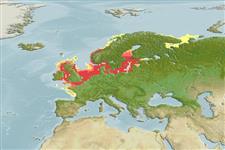Classification / Names
Common names from other countries
Main reference
Size / Weight / Age
Max length : 45.0 cm TL male/unsexed; (Ref. 4545); common length : 16.5 cm TL male/unsexed; (Ref. 682); max. published weight: 178.00 g (Ref. 6114); max. reported age: 10 years (Ref. 682)
Length at first maturity
Lm 12.8 range ? - ? cm
Environment
Marine; freshwater; brackish; pelagic-neritic; anadromous (Ref. 51243), usually ? - 50 m (Ref. 4545)
Climate / Range
Temperate, preferred 10°C (Ref. 107945); 70°N - 43°N, 9°W - 55°E
Distribution
North Atlantic: White Sea southward to western coasts of France including Baltic Sea, southern North Sea and British Isles (Ref. 4545); the Gironde estuary is the southern limit of his distribution (Ref. 51442). Landlocked populations in lakes of coastal areas of North, Baltic, White and Barents Sea. North to about 68° N in Scandinavia (Ref. 59043). The former nominal subspecies Osmerus eperlanus eperlanus is recorded from the coasts and drainage of White and Barents Seas westward through Baltic Sea to Denmark and it is primarily lacustrine (Ref. 4545). The former subspecies Osmerus eperlanus schonfoldi (Rutty 1772) is sympatric with the nominate subspecies in parts of Poland, Denmark and the Baltic, and it is primarily anadromous (Ref. 4545).
Countries | FAO areas | Ecosystems | Occurrences | Introductions
Short description
Dorsal
spines
(total): 0;
Dorsal
soft rays
(total): 9-12;
Anal
spines: 0;
Anal
soft rays: 12 - 16;
Vertebrae: 55 - 62. Body long and slim (Ref. 4545). Head rather pointed (Ref. 4545). Snout pointed (Ref. 4545). Upper jaw reaching to hind margin of eye, lower jaw projecting a little (Ref. 4545, Ref. 51442). Teeth in lower jaw larger than those of upper, strong teeth on tongue and canines on vomer (Ref. 4545). Dorsal fin origin behind base of pelvic fins (Ref. 4545). Incomplete lateral line is developed near the head (Ref. 51442). Dorsal side light olive green, flanks silver stripe, belly creamy white (Ref. 4545).
IUCN Red List Status (Ref. 115185)
Threat to humans
Harmless
Human uses
Fisheries: commercial
Tools
Special reports
Download XML
Internet sources
Estimates of some properties based on models
Phylogenetic diversity index
PD50 = 0.5625 many relatives (e.g. carps) 0.5 - 2.0 few relatives (e.g. lungfishes)
Trophic Level
3.5 ±0.42 se; Based on food items.
Resilience
Medium, minimum population doubling time 1.4 - 4.4 years (K=0.15-0.25; tm=2-4; tmax=10; Fec=10,000)
Vulnerability
Moderate vulnerability (43 of 100)
Price category
